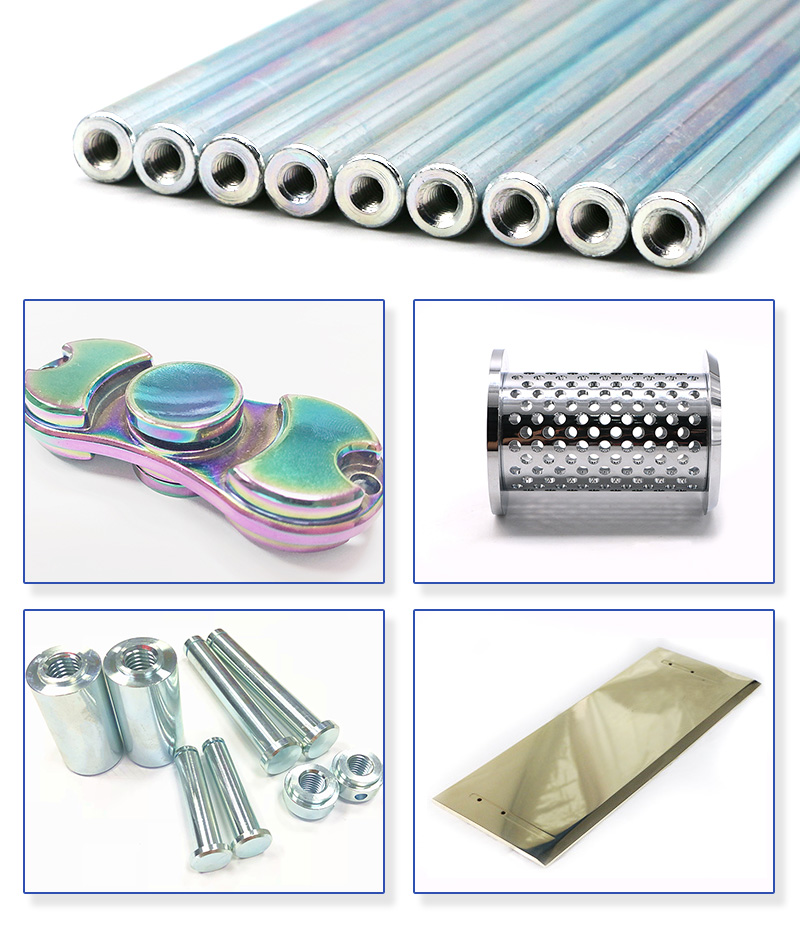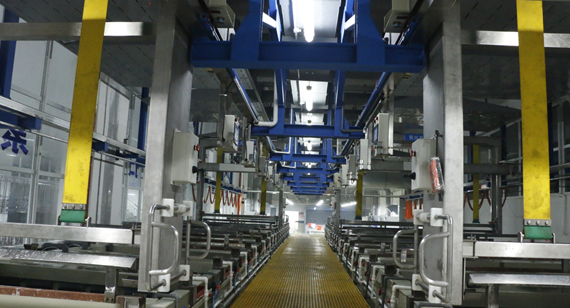15 years one-stop China custom CNC machining parts factory
 155 |
Published by VMT at Aug 29 2024
155 |
Published by VMT at Aug 29 2024
Galvanized metal is an indispensable anti-corrosion material in modern industry, widely used across various fields. This article aims to provide a comprehensive guide on galvanized metal, covering its definition, galvanizing processes, different methods, advantages, industrial applications, and common FAQs. It serves as a thorough reference for experts and professionals in the CNC machining parts manufacturing industry.
What is Galvanized Metal?
Galvanized metal refers to a surface treatment technique where a layer of zinc is applied to a metal or alloy surface to achieve purposes such as rust prevention, corrosion resistance, and improved aesthetics. This zinc layer not only significantly enhances the base metal's resistance to corrosion but also gives it a silver-white luster, improving its visual appeal.

What Types of Metals Can Be Galvanized?
Galvanizing is primarily used for steel and its alloys, such as steel sheets, steel pipes, and steel wires. Additionally, some ferrous metals like iron and copper can also undergo galvanizing treatment to improve their corrosion resistance. However, due to the chemical properties of zinc, it is not suitable for all metal surfaces, especially those that react strongly with zinc or form undesirable compounds.

The galvanizing process consists of three main stages: surface preparation of the metal, actual galvanizing, and post-galvanizing surface treatment. These stages work together to ensure a strong bond between the zinc layer and the base metal, as well as the quality and performance of the zinc coating itself.
Surface Preparation of the Metal
Before galvanizing, the metal surface must undergo rigorous preparation to remove contaminants such as oils and oxides. This typically includes steps like degreasing, pickling, and rinsing to ensure the metal surface is clean and free of impurities. After cleaning, a flux is applied to enhance the bonding between the zinc layer and the base metal.
Actual Galvanizing
The galvanizing process varies depending on the method used, such as hot-dip galvanizing or electro-galvanizing. Hot-dip galvanizing, the most common method, involves immersing the metal in molten zinc, forming a uniform coating on the surface through thermal diffusion. Electro-galvanizing, on the other hand, uses electrolysis to deposit a layer of zinc onto the metal surface.
Post-Galvanizing Surface Treatment
After galvanizing, additional treatments such as passivation are applied to enhance the corrosion resistance and appearance of the zinc coating. Passivation involves creating a dense oxide film on the surface of the zinc layer to prevent environmental factors from corroding the coating.
Galvanizing protects metal based on the following principles:
Acid Resistance: Zinc's chemical properties allow it to resist acid corrosion to some extent, protecting the base metal from acid damage.
Rust Prevention: Zinc has a lower electrode potential than iron, meaning it will corrode first in a humid environment, thus protecting the iron substrate from rusting.
Faster Corrosion of Zinc: This sacrificial anode protection mechanism is key to how the zinc layer protects the base metal.
There are various galvanizing methods, each with its unique advantages and suitable applications. Below are some common galvanizing methods.
Hot-Dip Galvanizing
Hot-dip galvanizing is the most widely used method, known for its uniform coating, strong adhesion, and excellent corrosion resistance. In this process, the metal is immersed in molten zinc, which forms a dense zinc layer on the surface through thermal diffusion. This method is suitable for large steel structures, wires, and sheets in mass production.
Pre-Galvanizing
Pre-galvanizing typically refers to galvanizing treatment done during the production of steel, such as in the production of hot-dip galvanized steel sheets. The resulting galvanized steel sheets have excellent surface quality and corrosion resistance, making them widely used in construction, automotive, and other fields.
Electro-Galvanizing
Also known as cold galvanizing, electro-galvanizing uses electrolysis to deposit a layer of zinc onto the metal surface. This method is suitable for small batch production and complex-shaped parts, offering uniform coating and controllable thickness. However, electro-galvanizing has lower production efficiency and higher costs.
Galvannealing
Galvannealing involves heat-treating the galvanized metal after the galvanizing process to improve adhesion and corrosion resistance of the coating. Through annealing, a stronger bond is formed between the coating and the base metal, and internal stresses within the coating are relieved.

Cost-Effective: Galvanized metal sheets are relatively inexpensive, with a long service life, reducing long-term maintenance costs.
Increased Durability: The zinc layer significantly enhances the base metal's corrosion resistance, extending its lifespan.
Triple Protection for the Substrate: The zinc layer not only resists chemical corrosion from acids and bases but also protects the base metal from electrochemical corrosion through the sacrificial anode mechanism.
Comprehensive Coverage: The galvanizing process ensures full, uniform coverage of the metal surface with no dead spots or omissions.
Reliable Coating: The bond between the zinc layer and the base metal is strong, providing reliable anti-corrosion protection.
Cost Efficiency: Galvanized metal sheets offer high cost-efficiency in processing, installation, and other stages, making them suitable for large-scale applications.
Quick Turnaround: The galvanizing process is relatively simple and fast, meeting the needs of rapid production, shortening production cycles, and reducing costs.
Galvanized metal is widely used in various industrial fields due to its excellent anti-corrosion properties and cost-effectiveness. From large infrastructure projects to everyday consumer products, galvanized metal plays a crucial role.
Wind and Solar Industries
In the wind and solar industries, galvanized metal is primarily used to manufacture structures such as wind turbine towers and solar mounts. These components are exposed to harsh environmental conditions, requiring excellent corrosion resistance and durability. Galvanizing effectively extends the service life of these structures, reduces maintenance costs, and ensures the stable operation of wind and solar power systems.
The automotive industry is one of the major application areas of galvanized metal. In automobile manufacturing, galvanized steel sheets are widely used in the production of body panels, chassis components, and more. Galvanized steel sheets offer good corrosion resistance, improved rigidity, and safety for the vehicle body. Additionally, the galvanizing process provides an aesthetically pleasing silver-white appearance, enhancing the overall quality of the vehicle.
In the industrial sector, galvanized metal is widely used to manufacture various mechanical parts, pipelines, storage tanks, and other equipment. These devices often operate in corrosive environments, such as in the chemical, petroleum, and pharmaceutical industries. Galvanizing effectively prevents surface corrosion, extends the service life of the equipment, and reduces downtime and failures caused by corrosion.
Construction Industry
The construction industry is another key area where galvanized metal is widely used. In construction, galvanized steel sheets are often used to make roofing, walls, awnings, and other components. Galvanizing not only enhances the corrosion resistance of these components but also provides a visually appealing finish. Additionally, galvanized metal has excellent workability, allowing for cutting, bending, welding, and other processing to meet design requirements.
Telecommunications Industry
In the telecommunications industry, galvanized metal is used to manufacture communication towers, cable trays, and other equipment. These devices are typically installed outdoors and must have excellent corrosion resistance and stability. Galvanizing protects the equipment surface from the effects of weathering and electrochemical corrosion, ensuring the normal operation of communication systems.
Galvanized metal is a crucial anti-corrosion material that plays an irreplaceable role in modern industry. Through the galvanizing process, a uniform and dense zinc layer is formed on the metal surface, effectively preventing corrosion and rusting. Galvanized metal not only offers cost-effective and durable advantages but is also widely used in wind and solar energy, automotive, industrial, construction, and telecommunications industries. With the advancement of technology and industrial development, galvanizing techniques will continue to innovate and improve, providing high-quality anti-corrosion solutions for more fields.

Does Galvanized Metal Rust?
Under normal circumstances, galvanized metal does not rust because the zinc layer effectively prevents the base metal from coming into contact with oxygen and moisture in the air, thus avoiding oxidation and rust. However, if the zinc layer is severely damaged or worn away, exposing the base metal, rusting may occur.
How Can You Tell if Metal is Galvanized?
You can determine if metal is galvanized through several methods, such as observing the surface color and luster (galvanized metal usually has a silver-white, smooth surface), using a magnet test (the zinc layer reacts weakly to magnets), and performing chemical analysis (like using acid or alkaline reagents to test the corrosion resistance of the coating).
Which is Better: Aluminum or Galvanized Steel?
Aluminum and galvanized steel each have their pros and cons, and the choice depends on the application. Aluminum is lightweight, strong, and highly resistant to corrosion, but more expensive. Galvanized steel is more affordable, easier to work with, and has good corrosion resistance, though it's heavier. Therefore, the decision should consider material performance, cost, and processing difficulty.
Can You Etch Galvanized Metal?
Yes, galvanized metal can be etched to create patterns or text. However, due to the presence of the zinc layer, some or all of it must be removed to expose the base metal surface before etching. Care must be taken to control the concentration and temperature of the etching solution to avoid excessive corrosion of the base metal.
Is Galvanized Metal Shiny or Dull?
Galvanized metal surfaces typically exhibit a shiny, silver-white luster due to the zinc layer's properties. However, the glossiness can vary depending on the thickness of the coating and the surface treatment process.
How Do You Remove a Galvanized Coating?
There are several methods to remove a galvanized coating, such as acid pickling, alkaline washing, or electrolytic stripping. Acid pickling is one of the most common methods, where a strong acid solution reacts with the zinc layer to remove it. However, care must be taken to control the acid concentration and temperature to avoid damaging the base metal. Other methods like alkaline washing and electrolytic stripping each have their own characteristics and application scenarios.
Is Galvanizing Waterproof?
Galvanizing itself does not directly provide waterproofing, but the zinc layer enhances the metal surface's corrosion resistance and weatherability, indirectly improving the structure's waterproofing. In applications requiring waterproofing, additional waterproof coatings or treatments are usually applied to the galvanized metal surface to further enhance the waterproof effect.
Why Use Galvanized Steel Instead of Stainless Steel?
Both galvanized steel and stainless steel offer good corrosion resistance, but they differ in cost, processing performance, and application scenarios. Galvanized steel is less expensive and easier to work with, making it suitable for situations where extreme corrosion resistance isn't necessary. Stainless steel offers higher corrosion resistance and better mechanical properties, but it is more expensive and harder to work with. Therefore, the choice should be based on specific needs and budget considerations.
